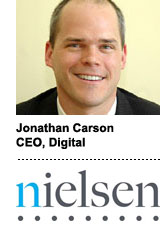 A new Nielsen targeting product aims to let advertisers buy online audiences based on their TV consumption patterns. It’s an extension of what the measurement firm has already done linking CPG purchase data to online media, and another mile marker on Nielsen’s road map for a digital media marketplace geared to the needs of broadcast media planners.
A new Nielsen targeting product aims to let advertisers buy online audiences based on their TV consumption patterns. It’s an extension of what the measurement firm has already done linking CPG purchase data to online media, and another mile marker on Nielsen’s road map for a digital media marketplace geared to the needs of broadcast media planners.
To build the data segments, Nielsen takes a representative subset of its online and TV panelists, observes how they behave across TV and the web, and extrapolates that to a larger audience. Those segments consist of things like shows most viewed, channels most viewed, light or heavy TV watchers, and genres. The segments can be accessed in a few ways, including through an API, direct matching, or server-to-server matching using Nielsen’s DMP, courtesy of eXelate. (More in the press release)
At launch, five media sellers are actively pushing the new TV segments — Microsoft, Adap.TV, Specific Media, Undertone, and Videology.
AdExchanger spoke with Jonathan Carson, Nielsen’s CEO of digital, about the new offering (called Online Audience Segments – TV Viewing) and how it ties in with the company’s Online Campaign Ratings product.
How does this fit with Nielsen’s history tying offline behavior to online ad buying?
We’ve been playing in the precision marketing space for a number of years. Our first forays into it were with our CPG purchase data. We’ve had a number of programs in the market for a bunch of years through which publishers are able to organize our audience into segments according to what people buy.
For instance Campbell’s Soup is able to buy an advertising campaign to reach people that buy a lot of soup. That’s been very successful for us. We’ve done it with CPG data, and we’ve also done it with Claritas Prizm Segments.
This release is the next very big step in that direction. This is bringing TV viewership data into the online advertising ecosystem. What that enables at the base level is for advertisers to buy audiences according to what they watch on television. If you’re looking for college sports fans or people that watch a lot of home design programming, this would be a way to reach [them] online.
The greater opportunity we see is this is a very big leap forward in cross platform advertising. We envision a day where any ad delivered online would be delivered with the context of whether that person has seen the ad on television as well. Agencies have for the past 15 years been talking about that type of cross-platform advertising. There just haven’t been sophisticated tools online in place.
It sounds like you envision this supporting TV-to-online attribution modeling, in addition to targeting.
What we’re tackling here is the delivery piece. The other bookend of this is our Nielsen Online Campaign Ratings (AdExchanger story), which does the back-end measurement to see whether the delivery and segmentation is successful. This is about organizing the audiences for ad delivery. NCR… tells you whether you succeeded in that.
Can you give us an update on Campaign Ratings product?
It’s been a really exciting process for us. We’ve moved into cross-platform campaign ratings now. We’re not just reporting the online GRP. We’re reporting the online GRP alongside the TV GRP and showing duplication. This has enabled advertisers to understand the reach & frequency they get with TV only, online only, and then both TV and online (duplicated).
If you marry that up with the new audience segments we’re announcing this week, that’s the full suite of cross platform advertising solutions we think the market’s been asking for.
You announced five media sellers that are offering new audience segments product. Why these five?
Those are all companies that we already do pretty advanced programs with. They make up a pretty substantial portion of the online video ecosystem. We think this solution is relevant to all types of online advertising but probably the most obvious starting point is online video.
Do you see the ad viewability issue as less of a pain point with online video than it is with display?
I think the industry is making fantastic strides toward dealing with the viewability issue. We have fully integrated viewability into Campaign Ratings through our partnership with AdSafe. It’s an important issue but it doesn’t take away from the potential benefit here.
What else?
The big story is that we’re bringing this data out in a way that’s totally integrated with the way the TV economy currently works. That was the thinking with Nielsen’s approach to bringing CPG data into the online ecosystem as well. We did it in a way that was aligned with all the consumer segments CPG companies use to run their businesses every day.
We anticipate that adoption with the big TV advertisers is going to be easier because we’re using all the data sets they’re used to dealing with in the television ecosystem for many decades.















